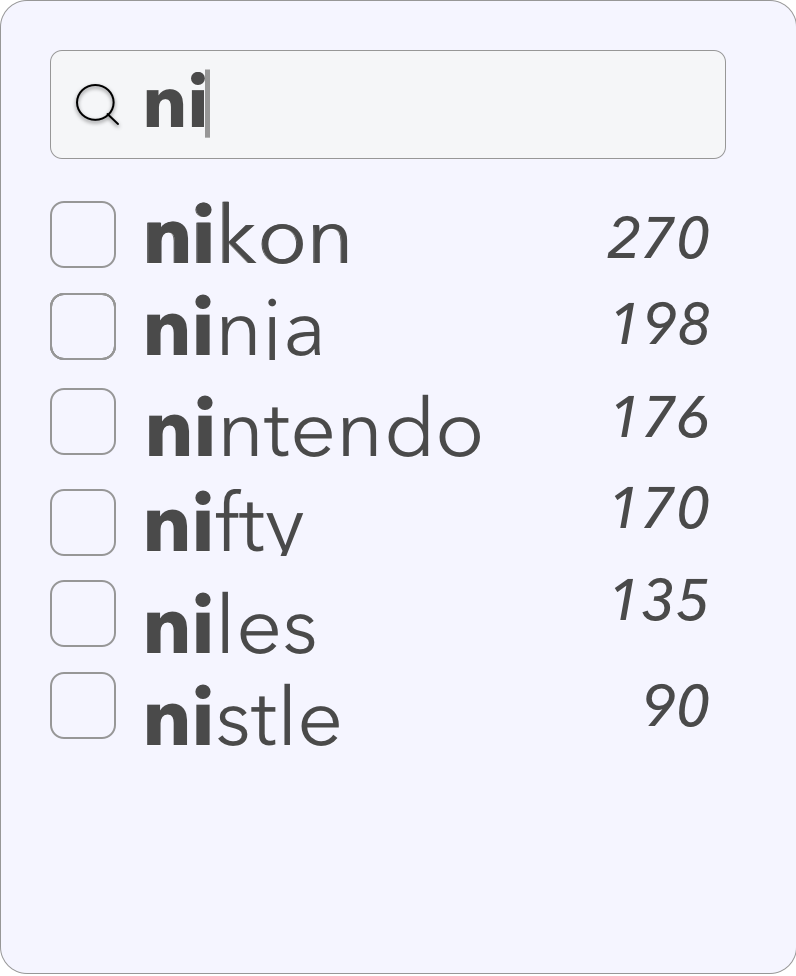search
ACL
$index->searchForFacetValues(string facetName, string facetQuery) $index->searchForFacetValues(string facetName, string facetQuery, [ // any searchParameters // any requestOptions ])
About this method #
Search for a set of values within a given facet attribute. Can be combined with a query.
This method enables you to search through the values of a facet attribute, selecting only a subset of those values that meet a given criteria.
Note For a facet attribute to be searchable, it must have been declared in the
attributesForFaceting index setting with the searchable() modifier.
Facet-searching only affects facet values. It does not impact the underlying index search.
The results are sorted by decreasing count. This can be adjusted via sortFacetValuesBy.
By default, maximum 10 results are returned. This can be adjusted via maxFacetHits.
This method is often used in combination with a user’s current search (using the search parameters). By combining facet and query searches, you control the number of facet values a user sees.

When you have 1000s of different values for a given facet attribute, it is impossible to display them all on the user’s interface. With Search for facet values, you allow your users to search within a specific faceted attribute (for example, brands, authors, or categories) without needing to create a separate index. This means that you can still display the most common occurrences for each facet at the top, but also enable the end user to search for a specific value to use for filtering.
By default, facet values are returned sorted by their count.
Examples #
Search for facet values#
1
2
# Search the values of the "category" facet matching "phone".
$index->searchForFacetValues("category", "phone");
Search for facet values with an additional searchParameters:#
1
2
3
4
5
// Search the "category" facet for values matching "phone"
// in records having "Apple" in their "brand" facet.
$index->searchForFacetValues("category", "phone", [
'filters' => 'brand:Apple'
]);
Search for facet values and send extra http headers#
1
2
3
4
# Search the "category" facet for values matching "phone" in records
$index->searchForFacetValues("category", "phone", [
'X-Algolia-User-ID' => 'user123'
]);
Parameters #
facetName
# |
type: string
Required
Attribute name. Note that for this to work, attribute must be declared in the
attributesForFaceting index setting with the |
facetQuery
# |
type: string
Required
The search query used to search the facet attribute. Follows the same rules for an index query: a single character, a partial word, a word, or a phrase. |
searchParameters
# |
type: key value mapping
default: No search parameters
Optional
The mapping of search parameters, to be used to search the underlying index. If set, the method will return facet values that both:
Using this parameter, therefore, aligns the count of each facet value
with the current search results. Without it, the count will be based on the whole index.
Note that the Settings that affect the returned facet values (maxFacetHits and sortFacetValuesBy) can be set as well. |
requestOptions
# |
type: key value mapping
default: No request options
Optional
A mapping of request options to send along with the query. |
Response #
In this section we document the JSON response returned by the API. Each language will encapsulate this response inside objects specific to the language and/or the implementation. So the actual type in your language might differ from what is documented.
JSON format#
1
2
3
4
5
6
7
8
9
10
11
12
13
14
15
16
{
"facetHits": [
{
"value": "Mobile phones",
"highlighted": "Mobile <em>phone</em>s",
"count": 507
},
{
"value": "Phone cases",
"highlighted": "<em>Phone</em> cases",
"count": 63
}
],
"exhaustiveFacetsCount": true,
"processingTimeMS": 1
}
facetHits
# |
list of facetHit
|
exhaustiveFacetsCount
# |
boolean
Whether the count returned for each facetHit is exhaustive. |
processingTimeMS
# |
integer
Processing time. |
facetHit #
value
# |
string
Facet value. |
highlighted
# |
string
Highlighted value. |
count
# |
integer
Number of times the value is present in the dataset. |
